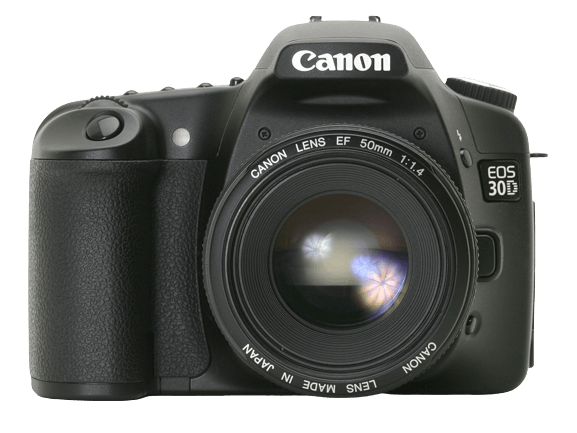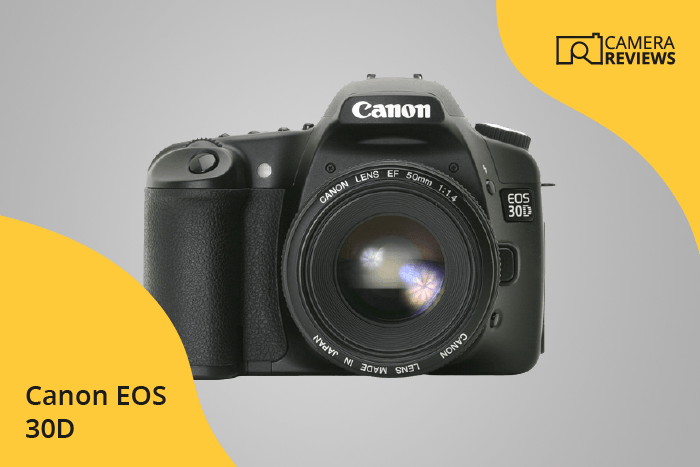Canon EOS 30D Specs and Scores

The Canon EOS 30D earns a score of 33/100, reflecting its general specifications. Announced on February 21, 2006, and released the same year, this DSLR camera has a launch price of $738. Measuring 144 x 106 x 74mm and weighing 784g (1.73lbs), the EOS 30D has been in the market for quite some time now. While it may not be a top contender in today’s market, the camera still has some features that appeal to certain users. It is important to consider the camera’s optics before making a final decision.
Canon EOS 30D Overview and Optics
The optics of the Canon EOS 30D receive a score of 41/100. This camera features an 8.2-megapixel resolution, a shooting speed of 5 frames per second, and a CMOS sensor. It utilizes the Digic II processor and has a DXOMARK score of 59 for the sensor. The sensor size is APS-C, and the lens mount is Canon EF-S. However, the camera lacks image stabilization and has an aspect ratio of 3:2.
Comparing the optics to today’s market, the Canon EOS 30D falls short in terms of resolution and image stabilization. Modern cameras often have higher megapixels and built-in image stabilization, which significantly improve image quality and reduce the impact of camera shake. The absence of these features in the Canon EOS 30D makes it less competitive in the current market.
Despite its lower score and outdated features, the Canon EOS 30D still has a reliable sensor and processor, providing decent image quality for casual photography. However, for those seeking cutting-edge technology and optimal performance, newer models with advanced optics are a better choice.
Canon EOS 30D Video Performance
The Canon EOS 30D, unlike many modern cameras, lacks video capabilities. It does not record video in any format or resolution. The 30D solely functions as a still photography camera.
Canon EOS 30D Features and Benefits
The Canon EOS 30D holds a feature score of 17 out of 100. It possesses a 2.5-inch screen with a resolution of 230,000 dots. The camera lacks modern features such as a touchscreen, flip screen, GPS, WiFi, and Bluetooth.
When evaluating the EOS 30D’s features against current market offerings, the camera falls short. The absence of a touchscreen, flip screen, and wireless connectivity options make it less user-friendly and adaptable for various shooting scenarios. Moreover, the lack of GPS hinders geotagging capabilities, which is a standard feature in many current camera models.
Despite its low feature score, the Canon EOS 30D might still appeal to photographers who prefer a simpler, more traditional camera. However, for those seeking the latest technology and features, the EOS 30D may not meet their expectations.
Canon EOS 30D Storage and Battery
The Canon EOS 30D receives a storage and battery score of 24 out of 100. This camera has one memory card slot and accepts Compact Flash (Type I or II) cards for storage. In today’s market, the single memory card slot may be limiting for some users, as many modern cameras offer dual slots for better storage capacity and versatility.
Regarding battery life, the EOS 30D provides 400 shots per charge with its BP-511A battery. However, this camera does not support USB charging. Compared to current cameras, the battery life is relatively low, since many models now offer extended battery life and convenient charging options.
While the Canon EOS 30D has some limitations in storage and battery life, it may still be a suitable option for those seeking a reliable camera with solid performance.
Canon EOS 30D Alternatives
Do you want to know how the Canon EOS 30D compares to its competitors? Have a look at the most popular comparisons for this camera below:
- Canon EOS Rebel T7 / 2000D vs EOS 30D
- Canon EOS 40D vs EOS 30D
- Canon EOS 30D vs Nikon D60
- Canon EOS 30D vs Nikon D3200
- Canon EOS 1D Mark II N vs EOS 30D
- Canon EOS 50D vs EOS 30D
Canon EOS 30D FAQ
Does the Canon EOS 30D Have Built-in Image Stabilization?
The Canon EOS 30D does not have built-in image stabilization. However, it supports lenses with optical image stabilization, which can help reduce camera shake and improve image quality.
Does the Canon EOS 30D Support 4K Video Recording?
The Canon EOS 30D does not support 4K video recording as it does not have video functionality. It is primarily designed for photography purposes.
What Size Sensor Does The Canon EOS 30D Have?
The Canon EOS 30D features an APS-C sized sensor, which is smaller than a full-frame sensor but still provides excellent image quality and performance.
Does the Canon EOS 30D Have a Dual Memory Card Slot?
The Canon EOS 30D does not have a dual memory card slot. It only has a single CompactFlash card slot for storing images.
Does the Canon EOS 30D Have a Touch Screen?
The Canon EOS 30D does not have a touch screen. It relies on physical buttons and dials for navigating menus and adjusting settings.
Does the Canon EOS 30D Have Wi-Fi and Bluetooth?
The Canon EOS 30D does not have built-in Wi-Fi or Bluetooth connectivity. It cannot be connected wirelessly to other devices for transferring images or remote control.
Does the Canon EOS 30D Have GPS?
The Canon EOS 30D does not have built-in GPS functionality. Geotagging photos or tracking location data is not possible with this camera.
Is the Canon EOS 30D Weather Sealed?
The Canon EOS 30D is not weather-sealed, which means it is not designed to withstand harsh weather conditions or extreme environments without additional protection.
Does the Canon EOS 30D Have a Built-in Flash?
Yes, the Canon EOS 30D has a built-in pop-up flash that can be used for additional lighting when needed in various shooting situations.

